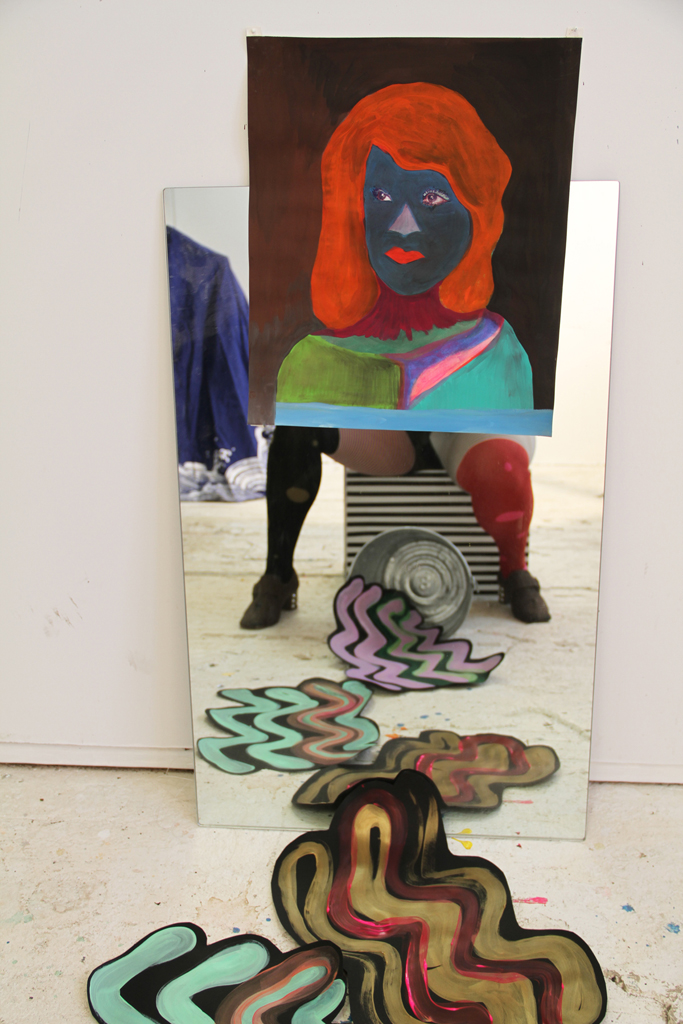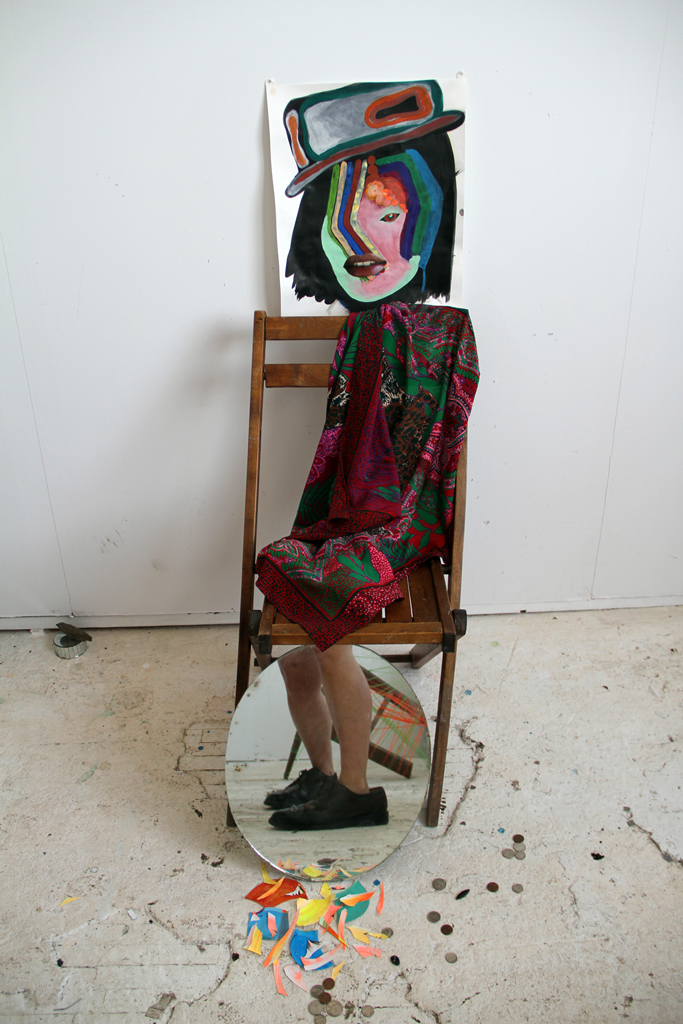Thea Liberty Nichols: I left your studio, which you were kind enough to have me visit the other day, inspired to make new work because hearing about the “instructions” you give yourself really resonated with me. Rather then functioning as rules or restrictions, it sounded like they seeded your impulse to experiment and improvise, and, as you noted, the outcome of your work could still surprise you in the end. Can you recount a series of instructions for us and tell us how they’ve shaped this new body of work alongside the other mysteries and happy coincidences that come along with innovating and problem solving?
Selina Trepp: In the past year, I have been focusing on my relationship to painting. Focusing on painting in my case means addressing my relationship to my mother and grandmother. They are both painters.
Grandmother = Artist – Painter
Mother = Artist – Painter
Me = Artist avoiding painting
Thinking about the above I realized that the most challenging thing I could do within my own practice, was to paint.
To help me in that endeavor I came up with a framework, a physical construction consisting of a crude one-way mirror and a camera, as well as a set of instructions to work with.
Instructions to myself:
Process Part 1
Video: Paint a self-portrait by tracing my mirror image on a one-way mirror.
- Sit in front of a one-way mirror and paint a self-portrait by tracing my mirror image while the camera on the other side of the mirror records the process.
- The camera records for 12 minutes.
(This process resulted in the video portrait being erased by the painted self-portrait over time)
Process Part 2
Painting: Use up the leftover paint usefully
- Use up the paint left over on the palette used for the self-portrait. Paint based on discussions I had with my grandmother Rhoda about painting. All the decisions in the making of this painting are purely based on emotion, instinct and chance. Rhoda was an expressionist painter.
(This process resulted in a stack of paintings of imaginary faces, a cast of characters)
Process Part 3
Photo: Make the painting perform.
- Look at the painting and figure out what it is telling me.
- Set up scenarios with it and other elements growing in my studio, such as mirrors, sculptures, and various residues, to create a photo in which the painting, the space itself and myself become one as the performer. (This resulted in a series of photos, The Relatives)
I repeated these processes regularly from July 2010 – May 2011.
Coincidentally, I found out that I was pregnant very early on in the project, thus this body of work in a strange way also documents my pregnancy.
TLN: Mirrors are a re-occurring media in your work, perhaps because of their hybrid ability to project or reflect and to absorb. I know in some of the new video pieces you’re working on, you construct a “mirror” from a piece of glass and a black curtain, but that video work itself also explores the erasure of the photographic image of your portrait by that of the painted image of your self-portrait. How did you hit upon this mirroring technique and how does it relate to your overarching engagement with analog versus digital technology?
ST: Mirrors have been in my work since the very early stages. I am intrigued by their ability to create what I think of as simple magic, or analogue trickery. My interest in the analogue versus the digital is an expression of my desire to have effects be performed rather than applied.
In the recent self-portrait videos, I am tracing my image on a mirror to achieve the effect of the photographic portrait being erased by the painted self-portrait. By taking the analogue route, simultaneously mirroring, painting, and filming, I am confronted with the difficulty that it is actually impossible to trace my mirror image, because as soon as I place the brush on the mirror’s surface, what I am trying to trace is obstructed. Dealing with this handicap helps my performance transcend theatrics and instead becomes documented process.
TLN: In your new body of work, your studio is pictured as not just the site of creation, but as an integral element that exudes an almost anthropomorphic quality. As an artist who’s exhibited in galleries and a musician who’s played in clubs and bars, can you tell us a little more about how your work is framed by the places it’s executed, performed or displayed in?
ST: It is important to me to work in a varied context. Having the option to move between the art and the music world has given me multiple registers to work with.
My studio practice allows me to experiment in depth. I work in a variation of media and compose the entire experience inside the studio as well as in the exhibition space. Once the work is installed, I can step away and the work has an existence independent of me.
Collaborating with musicians I perform live playing the videolah, a video synthesizer, creating video projections in real time. Live performance has the benefit of immediacy. The fleeting nature of performance creates a unique bond between the audience and myself; it only exists in the moment and only to those who are there.
A big difference between a performance and an exhibition for me is that in an exhibition the artwork independently interacts with the audience, while in a performance it is me interacting with the audience playing the videolah and singing.
SELINA TREPP (Swiss/American, b. 1973, Zurich, Switzerland) lives and works in Chicago. She received her B.F.A. from the Art Institute of Chicago in 1998 and her M.F.A. from the University of Illinois Chicago in 2007. Her artistic output comes in a multitude of media: installation, video, drawing, painting, photography, and sculpture. Additionally, she developed a practice of live video performance collaborating with several of Chicago’s finest musicians and has been performing on a regular basis in different venues in the city and abroad as well as one half of the duo Spectralina, a collaboration with Dan Bitney. Selina Trepp’s work has been exhibited internationally and has received several awards and honors including the Swiss Art Award and the Illinois Arts Council Fellowship. She is represented by Andrew Rafacz Gallery.








Pingback: Artist Avoiding Painting « Mutualisms